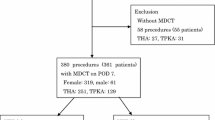Abstract
Background
Preventing pulmonary embolism is a priority after major musculoskeletal surgery. The literature contains discrepant data regarding the influence of anticoagulation on the incidence of pulmonary embolism after joint arthroplasty. The American College of Chest Physicians guidelines recommend administration of oral anticoagulants (warfarin), aiming for an international normalized ratio (INR) level between 2 and 3. However, recent studies show aggressive anticoagulation (INR > 2) can lead to hematoma formation and increased risk of subsequent infection.
Questions/purposes
We asked whether an INR greater than 2 protects against pulmonary embolism.
Patients and Methods
We identified 9112 patients with 10,122 admissions for joint arthroplasty between 2004 and 2008. All patients received warfarin for prophylaxis, aiming for an INR level of 2 or lower. We assessed 609 of 10,122 admissions (6%) for pulmonary embolism using CT, ventilation/perfusion scan, or pulmonary angiography, and 163 of 10,122 admissions (1.6%) had a proven pulmonary embolism.
Results
Fifteen of 163 admissions (9%) had an INR greater than 2 before or on the day of workup compared to 35 of 446 admissions (8%) who were negative. We observed no difference between the INR values in patients with or without pulmonary embolism.
Conclusions
We found no clinically relevant difference in the INR values of patients who did or did not develop pulmonary embolism. The risk of bleeding should be weighed against the risk of pulmonary embolism when determining an appropriate target INR for each patient, as an INR less than 2 may reduce the risk of bleeding while still protecting against pulmonary embolism.
Level of Evidence
Level III, therapeutic study. See Instructions to Authors for a complete description of levels of evidence.



Similar content being viewed by others
References
Balderston RA, Graham TS, Booth RE Jr, Rothman RH. The prevention of pulmonary embolism in total hip arthroplasty: evaluation of low-dose warfarin therapy. J Arthroplasty. 1989;4:217–221.
Callaghan JJ, Dorr LD, Engh GA, Hanssen AD, Healy WL, Lachiewicz PF, Lonner JH, Lotke PA, Ranawat CS, Ritter MA, Salvati EA, Sculco TP, Thornhill TS. Prophylaxis for thromboembolic disease: recommendations from the American College of Chest Physicians—are they appropriate for orthopaedic surgery? J Arthroplasty. 2005;20:273–274.
Charlson ME, Pompei P, Ales KL, MacKenzie CR. A new method of classifying prognostic comorbidity in longitudinal studies: development and validation. J Chronic Dis. 1987;40:373–383.
Clark NP, Witt DM, Delate T, Trapp M, Garcia D, Ageno W, Hylek EM, Crowther MA. Thromboembolic consequences of subtherapeutic anticoagulation in patients stabilized on warfarin therapy: the low INR study. Pharmacotherapy. 2008;28:960–967.
Deyo RA, Cherkin DC, Ciol MA. Adapting a clinical comorbidity index for use with ICD-9-CM administrative databases. J Clin Epidemiol. 1992;45:613–619.
Dorr LD, Gendelman V, Maheshwari AV, Boutary M, Wan Z, Long WT. Multimodal thromboprophylaxis for total hip and knee arthroplasty based on risk assessment. J Bone Joint Surg Am. 2007;89:2648–2657.
Enyart JJ, Jones RJ. Low-dose warfarin for prevention of symptomatic thromboembolism after orthopedic surgery. Ann Pharmacother. 2005;39:1002–1007.
Fitzgerald RH Jr, Spiro TE, Trowbridge AA, Gardiner GA Jr, Whitsett TL, O’Connell MB, Ohar JA, Young TR. Prevention of venous thromboembolic disease following primary total knee arthroplasty: a randomized, multicenter, open-label, parallel-group comparison of enoxaparin and warfarin. J Bone Joint Surg Am. 2001;83:900–906.
Freedman KB, Brookenthal KR, Fitzgerald RH Jr, Williams S, Lonner JH. A meta-analysis of thromboembolic prophylaxis following elective total hip arthroplasty. J Bone Joint Surg Am. 2000;82:929–938.
Geerts WH, Bergqvist D, Pineo GF, Heit JA, Samama CM, Lassen MR, Colwell CW. Prevention of venous thromboembolism: American College of Chest Physicians Evidence-Based Clinical Practice Guidelines (8th Edition). Chest. 2008;133:381S–453S.
Johanson NA, Lachiewicz PF, Lieberman JR, Lotke PA, Parvizi J, Pellegrini V, Stringer TA, Tornetta P 3rd, Haralson RH 3rd, Watters WC 3rd. American Academy of Orthopaedic Surgeons Clinical Practice Guideline on prevention of symptomatic pulmonary embolism in patients undergoing total hip or knee arthroplasty. J Bone Joint Surg Am. 2009;91:1756–1757.
Mantilla CB, Horlocker TT, Schroeder DR, Berry DJ, Brown DL. Frequency of myocardial infarction, pulmonary embolism, deep venous thrombosis, and death following primary hip or knee arthroplasty. Anesthesiology. 2002;96:1140–1146.
Murray DW, Britton AR, Bulstrode CJ. Thromboprophylaxis and death after total hip replacement. J Bone Joint Surg Br. 1996;78:863–870.
O’Reilly RF, Burgess IA, Zicat B. The prevalence of venous thromboembolism after hip and knee replacement surgery. Med J Aust. 2005;182:154–159.
Parvizi J, Azzam K, Rothman RH. Deep venous thrombosis prophylaxis for total joint arthroplasty: American Academy of Orthopaedic Surgeons guidelines. J Arthroplasty. 2008;23:2–5.
Parvizi J, Jacovides CL, Bican O, Purtill JJ, Sharkey PF, Hozack WJ, Rothman RH. Is deep vein thrombosis a good proxy for pulmonary embolus? J Arthroplasty. 2010;25:138–144.
Pellegrini VD Jr, Sharrock NE, Paiement GD, Morris R, Warwick DJ. Venous thromboembolic disease after total hip and knee arthroplasty: current perspectives in a regulated environment. Instr Course Lect. 2008;57:637–661.
Phillips CB, Barrett JA, Losina E, Mahomed NN, Lingard EA, Guadagnoli E, Baron JA, Harris WH, Poss R, Katz JN. Incidence rates of dislocation, pulmonary embolism, and deep infection during the first six months after elective total hip replacement. J Bone Joint Surg Am. 2003;85:20–26.
Pulido L, Parvizi J, Macgibeny M, Sharkey PF, Purtill JJ, Rothman RH, Hozack WJ. In hospital complications after total joint arthroplasty. J Arthroplasty. 2008;23:139–145.
Sharrock NE, Gonzalez Della Valle A, Go G, Lyman S, Salvati EA. Potent anticoagulants are associated with a higher all-cause mortality rate after hip and knee arthroplasty. Clin Orthop Relat Res. 2008;466:714–721.
Author information
Authors and Affiliations
Corresponding author
Additional information
Javad Parvizi is a consultant for Stryker Orthopaedics (Mahwah, NJ) and has intellectual properties on SmarTech (Philadelphia, PA); Richard H. Rothman receives royalties and is a consultant for Stryker Orthopaedics (Mahwah, NJ).
Each author certifies that his/her institution has approved the human protocol for this investigation and that all investigations were conducted in conformity with ethical principles of research.
Appendix 1
Appendix 1

About this article
Cite this article
Hansen, P., Zmistowski, B., Restrepo, C. et al. Does International Normalized Ratio Level Predict Pulmonary Embolism?. Clin Orthop Relat Res 470, 547–554 (2012). https://doi.org/10.1007/s11999-011-2007-7
Published:
Issue Date:
DOI: https://doi.org/10.1007/s11999-011-2007-7




